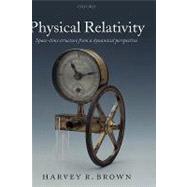
| Preface | vii | ||||
| Acknowledgements | x | ||||
| 1. Overview | 1 | (10) | |||
|
1 | (1) | |||
|
2 | (2) | |||
|
4 | (1) | |||
|
5 | (3) | |||
|
8 | (2) | |||
|
10 | (1) | |||
| 2. The Physics of Coordinate Transformations | 11 | (22) | |||
|
11 | (3) | |||
|
14 | (12) | |||
|
15 | (1) | |||
|
16 | (2) | |||
|
18 | (4) | |||
|
22 | (1) | |||
|
23 | (2) | |||
|
25 | (1) | |||
|
26 | (2) | |||
|
28 | (5) | |||
| 3. The Relativity Principle and the Fable of Albert Keinstein | 33 | (8) | |||
|
33 | (4) | |||
|
33 | (2) | |||
|
35 | (2) | |||
|
37 | (1) | |||
|
38 | (2) | |||
|
40 | (1) | |||
| 4. The Trailblazers | 41 | (28) | |||
|
42 | (4) | |||
|
43 | (3) | |||
|
46 | (2) | |||
|
48 | (4) | |||
|
52 | (6) | |||
|
58 | (4) | |||
|
62 | (4) | |||
|
66 | (3) | |||
| 5. Einstein's Principle-theory Approach | 69 | (22) | |||
|
69 | (2) | |||
|
71 | (3) | |||
|
74 | (3) | |||
|
74 | (1) | |||
|
75 | (2) | |||
|
77 | (3) | |||
|
77 | (1) | |||
|
78 | (1) | |||
|
78 | (2) | |||
|
80 | (2) | |||
|
82 | (5) | |||
|
82 | (2) | |||
|
84 | (1) | |||
|
85 | (2) | |||
|
87 | (2) | |||
|
89 | (2) | |||
| 6. Variations on the Einstein Theme | 91 | (22) | |||
|
91 | (1) | |||
|
92 | (3) | |||
|
94 | (1) | |||
|
95 | (10) | |||
|
98 | (4) | |||
|
102 | (3) | |||
|
105 | (4) | |||
|
109 | (1) | |||
|
110 | (3) | |||
| 7. Unconventional Voices on Special Relativity | 113 | (15) | |||
|
113 | (1) | |||
|
114 | (4) | |||
|
118 | (1) | |||
|
119 | (3) | |||
|
122 | (6) | |||
|
122 | (2) | |||
|
124 | (2) | |||
|
126 | (2) | |||
| 8. What is Special Relativity? | 128 | (22) | |||
|
128 | (4) | |||
|
129 | (2) | |||
|
131 | (1) | |||
|
132 | (7) | |||
|
134 | (1) | |||
|
135 | (1) | |||
|
136 | (3) | |||
|
139 | (5) | |||
|
140 | (3) | |||
|
143 | (1) | |||
|
144 | (6) | |||
|
145 | (2) | |||
|
147 | (3) | |||
| 9. The View from General Relativity | 150 | (28) | |||
|
150 | (1) | |||
|
151 | (10) | |||
|
151 | (3) | |||
|
154 | (2) | |||
|
156 | (5) | |||
|
161 | (2) | |||
|
163 | (6) | |||
|
165 | (4) | |||
|
169 | (6) | |||
|
169 | (3) | |||
|
172 | (3) | |||
|
175 | (3) | |||
| Appendix A Einstein on General Covariance | 178 | (4) | |||
| Appendix B Special Relativity and Quantum Theory | 182 | (11) | |||
|
182 | (1) | |||
|
183 | (4) | |||
|
187 | (3) | |||
|
190 | (3) | |||
| Bibliography | 193 | (18) | |||
| Index | 211 |
The New copy of this book will include any supplemental materials advertised. Please check the title of the book to determine if it should include any access cards, study guides, lab manuals, CDs, etc.
The Used, Rental and eBook copies of this book are not guaranteed to include any supplemental materials. Typically, only the book itself is included. This is true even if the title states it includes any access cards, study guides, lab manuals, CDs, etc.